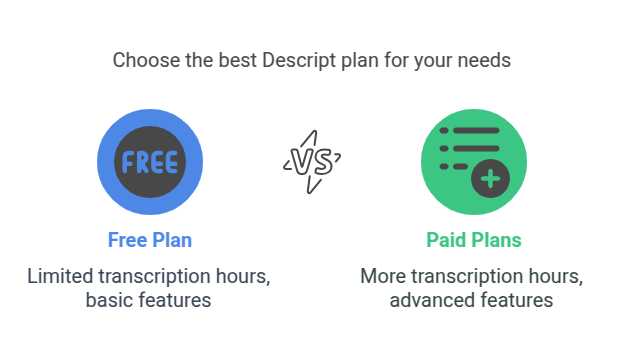Descript revolutionizes Podcast Editing with AI tools. Edit audio like text, generate voiceovers, and boost quality fast. Try Descript now and save hours!
If You’re Not Using Descript, You’re Falling Behind
Okay, let’s talk.
Seriously.
The world is changing.
Faster than you think.
Especially if you’re creating anything with audio.
Voice work. Music snippets. Podcasting.
It’s all getting automated.
Smarter.
AI is everywhere.
And if you’re still grinding away with old-school tools…
Doing things the hard way…
Man, you’re leaving money, time, and sanity on the table.
Look, I get it. New tools can be scary.
Another subscription. Another learning curve.
But some tools aren’t just ‘new’.
They’re game-changers.
They redefine how you work.
Descript is one of those tools.
Especially if you’re in the thick of Voice and Music Generation, particularly when it comes to Podcast Editing.
This ain’t just another AI gimmick.
This is built for results.
Let me show you why.
Table of Contents
- What is Descript?
- Key Features of Descript for Podcast Editing
- Benefits of Using Descript for Voice and Music Generation
- Pricing & Plans
- Hands-On Experience / Use Cases
- Who Should Use Descript?
- How to Make Money Using Descript
- Limitations and Considerations
- Final Thoughts
- Frequently Asked Questions
What is Descript?
Alright, straight talk. What exactly *is* Descript?
Think of it as a word processor, but for audio and video.
Seriously.
You upload your recording – your podcast episode, your voiceover, whatever.
Descript transcribes it automatically. Pretty fast, actually.
Then, you edit the audio… by editing the text transcript.
Mind blown yet?
If you delete a word from the transcript, Descript cuts that word out of the audio.
If you move a sentence in the transcript, Descript moves that section of the audio.
It’s like magic, but it’s just smart AI.
This completely flips the script on traditional audio editing. No more staring at waveforms, trying to find that one ‘um’ or pause.
You just read the text. See the mistake. Delete it. Done.
It’s designed for creators. For marketers. For anyone who works with spoken word and needs it polished fast.
Podcasters are loving it. It cuts down editing time dramatically.
Video editors use it for rough cuts and transcription.
Even writers use it to transcribe interviews or dictate content.
It’s building an all-in-one platform for media creation, but its roots are deep in audio and transcription.
It takes the pain out of editing. That’s the core promise.
And for anyone in Podcast Editing, where hours are often spent on tedious cuts, this is a godsend.
It makes the process visual and intuitive, like editing a document.
That’s Descript at its heart: text-based media editing. Simple concept, massive impact.
Key Features of Descript for Podcast Editing
Okay, let’s drill down into what makes Descript specifically powerful for podcasts.
- Transcription & Text-Based Editing:
This is the headliner. Upload your raw audio. Descript transcribes it, usually within minutes.
You get a document-like interface.
Every word is linked to the audio.
Want to remove filler words like ‘ums’, ‘ahs’, ‘you knows’? Descript can highlight them automatically.
You can remove them with a single click. Or remove all instances at once.
This saves hours compared to manually finding these in a waveform editor.
Deleting sentences is as easy as hitting backspace.
Rearranging sections? Cut and paste text. Descript handles the audio.
This feature alone is worth the price of admission for serious podcasters.
- Overdub & Studio Sound:
This is where the AI gets really clever.
Overdub allows you to create a realistic clone of your voice.
You train it by uploading a sample of your voice.
Then, if you make a mistake in your recording, or need to add a sentence, you don’t need to re-record.
Just type the new sentence into the transcript.
Descript’s Overdub feature generates audio of you saying those words, in your voice.
It’s not perfect for long paragraphs, but for quick corrections or additions, it’s insane.
Studio Sound is another AI trick.
It removes background noise, echo, and improves voice clarity with one click.
Makes it sound like you recorded in a professional studio, even if you were in your kitchen.
Huge time saver for cleaning up audio quality.
- Multitrack Editing & Collaboration:
Podcasts often have multiple speakers. Guest audio, intro music, sound effects.
Descript handles multitrack projects. You can see and edit different audio tracks within the same interface.
The transcript shows who is speaking, making it easy to follow conversations.
It also has built-in collaboration features.
You can share projects with team members or editors.
They can make edits, leave comments, and track changes, just like Google Docs.
This streamlines the production process if you work with others.
No more sending large audio files back and forth.
These features combined drastically reduce the time and effort needed for Voice and Music Generation projects, especially multi-person podcasts.
They make Podcast Editing accessible and efficient, even for complex episodes.
Benefits of Using Descript for Voice and Music Generation

Alright, let’s talk about the *results* you get with Descript.
Why bother?
Time Savings. Period.
This is the big one. Traditional audio editing is SLOW.
Scrolling waveforms. Clicking and dragging little clips. Zooming in on tiny sounds.
Descript makes it text-speed.
If you can read and type, you can edit audio.
Cutting out a minute-long tangent takes seconds, not minutes.
Removing all those ‘ums’ takes one click, not hundreds.
I’ve seen people cut their editing time by 50-80%.
Think about what you could do with those extra hours. More content? More marketing? More sleep?
Improved Quality & Consistency.
Studio Sound is genuinely good. It cleans up audio distortion and makes voices sound clearer.
This is huge for perceived professionalism. Bad audio equals unprofessional podcast, instantly.
Overdub allows for seamless corrections. No awkward jump cuts where you patched something in.
It helps maintain a smooth flow, even when you mess up.
Plus, the ease of editing means you’re more likely to remove unnecessary pauses and filler words.
This makes your content tighter, more engaging, and more professional.
Consistency across episodes becomes easier when the tools are this efficient.
Lower Barrier to Entry.
Audio editing software can be intimidating. Loads of buttons, complex interfaces.
Descript looks like a document. If you’ve ever used Google Docs or Microsoft Word, you can figure this out.
This means you don’t need to be an audio engineer to produce a great-sounding podcast.
Anyone with a basic understanding of text editing can jump in.
This opens up Podcast Editing to more people. Solo creators, small teams, anyone wanting to tell their story without a massive production budget or steep learning curve.
It democratizes high-quality audio production.
These benefits add up. More time, better quality, less frustration. That’s the Descript advantage.
Pricing & Plans

Okay, let’s talk brass tacks. How much does this cost?
Because efficiency is great, but it has to make financial sense.
Descript has a few tiers.
Yes, there is a free plan.
The free plan is good for testing the waters. You get limited transcription hours per month (usually one or two).
It lets you try the core text-based editing and transcription.
It’s enough to know if the workflow clicks for you.
But if you’re serious about podcasting or doing any real volume of audio work, you’ll hit those limits fast.
The Creator plan is the next step up. This is where you get significant transcription hours (often 10 hours per month or more).
You unlock features like Filler Word Removal, Studio Sound, and Overdub.
This is usually the sweet spot for individual podcasters or content creators.
Then there’s the Pro plan. More transcription hours, more Overdub usage, advanced features, and collaboration tools are more robust.
This is for teams, agencies, or power users.
They also have custom Enterprise plans for bigger companies.
Pricing is typically monthly or annual (annual saves you money).
How does it compare?
Traditional audio editors like Audacity (free) or Adobe Audition (subscription, part of Creative Cloud) require manual editing. They are powerful but lack the text-based workflow and AI features like Studio Sound and Overdub.
Some tools offer transcription services, but they don’t integrate editing the way Descript does.
Other AI audio tools might focus only on cleaning audio or generating voice, but not combine everything.
Descript’s value is in the all-in-one platform built around the text-based editing concept.
You’re paying for the efficiency and the unique AI features.
For many podcasters, the time saved quickly justifies the monthly cost. Hours saved equal money saved or earned.
Evaluate your own volume of audio work and see which plan fits your needs. Don’t be afraid to start free and upgrade as you grow.
Hands-On Experience / Use Cases
Let me tell you how this thing *actually* works in practice.
Because features lists are one thing, using it is another.
Imagine you just finished recording a 45-minute podcast interview.
Raw audio file. Full of pauses, maybe a cough, a plane flying overhead.
You drag it into Descript.
Give it a few minutes. It transcribes the whole thing.
Now you see the entire interview as text. Like an article draft.
Okay, first pass: read through the transcript.
See that bit where you totally lost your train of thought? Highlight the text, hit delete. Boom. Gone from the audio.
Guest said ‘um’ seventeen times? Find the ‘ums’ in the transcript. Descript can highlight them. Select them all. Click ‘Remove Filler Words’. Select how you want to handle them (delete or shorten the pause). Done. All those ‘ums’ are reduced or gone.
You notice the audio sounds a bit echoey? Click the track, enable ‘Studio Sound’. Listen back. Instantly better. Less echo, clearer voice.
You need to add a quick intro sentence? Type it in. Use Overdub. It says it in your voice. Place it at the beginning.
See that whole section that went off-topic? Highlight the paragraphs in the transcript. Delete. The episode is now tighter.
Need a specific clip for social media? Find the relevant text section, copy it, create a new composition, paste it. Edit that shorter clip down. Add captions automatically (Descript does that too). Export as a video.
This is how it flows. It’s iterative. It’s visual. It’s fast.
Instead of hours spent waveform editing, you spend time reading, cutting text, and letting the AI handle the audio magic.
Use case: Multi-host podcast. Upload each host’s audio track. Descript transcribes and identifies who is speaking. Edit the conversation flow by editing the text. Easy to see where one person interrupts or where someone needs to be cut out briefly.
Use case: Solo creator doing voiceovers. Record once. Use Overdub for small edits or corrections. Save a ton of time re-recording.
Use case: Transcribing and cleaning up raw interview audio for a documentary or course. The text-based system makes it easy to pull quotes and edit snippets.
The usability is high if you’re comfortable with text editing. The power comes from linking text to audio directly and those smart AI features.
Who Should Use Descript?

Okay, who is this tool *really* for?
Who gets the most bang for their buck?
If you’re creating content that involves spoken audio, pay attention.
Podcasters: This is the obvious one. Whether you’re a solo host, have co-hosts, or interview guests, Descript fundamentally changes Podcast Editing. It’s built for this workflow. Beginners and experienced pros alike benefit from the speed and ease.
Video Creators: Especially those who do talking head videos, interviews, or screencasts. Descript handles video too. Edit your video by editing the transcript. Great for rough cuts, removing errors, and generating captions automatically.
Marketers & Content Teams: Need to repurpose long-form audio or video? Descript makes it easy to pull snippets, create audiograms or video clips for social media. Transcribe webinars or meetings. Create short promotional videos fast.
Educators & Course Creators: Recording lectures, tutorials, or course modules? Descript simplifies editing and transcription. Make quick fixes, add clarity, and provide searchable transcripts for students.
Writers & Journalists: Transcribe interviews quickly and accurately. Use the text to write articles or book sections. The ability to jump between text and audio is perfect for verification and quoting.
Anyone doing Voiceovers: Whether for ads, explainer videos, or narration. Descript’s Overdub can save recording time, and the editing is much faster than traditional methods.
If your workflow currently involves:
– Spending hours manually editing audio or video.
– Paying for separate transcription services.
– Struggling with complex audio software.
– Wishing you could correct recording mistakes without re-recording.
– Needing to easily repurpose audio/video content.
Then Descript is probably for you.
It’s particularly powerful for solo creators and small teams who need to wear multiple hats and can’t afford to spend all day editing.
It scales well too, with collaboration features for larger projects.
In short: if you talk into a microphone or camera and need to make that recording better, Descript is a tool you should investigate.
How to Make Money Using Descript
Alright, the bottom line. Can this tool actually help you put money in your pocket?
Absolutely.
Descript isn’t just about saving time (though that saves you money). It enables new services and boosts efficiency for existing ones.
- Offer Podcast Editing Services:
This is a direct one. Many businesses, coaches, and creators want podcasts but don’t have the time or skills to edit.
Descript makes you a much faster and more efficient podcast editor.
You can take on more clients or charge competitive rates while saving hours on each project.
Your turnaround time will be quicker than editors using traditional methods.
Highlight your speed and use of AI tools (like Studio Sound) as a selling point.
You can specialise in cleaning up audio, removing filler words, or creating tight, engaging episodes – all things Descript excels at.
Hourly rate or per-episode pricing becomes more profitable when editing takes a fraction of the time.
- Provide Transcription Services:
Descript’s transcription is fast and reasonably accurate. While not perfect, it provides a solid base.
You can offer premium transcription services where you use Descript to get the initial transcript, then quickly proofread and correct it using the text-based editor.
This is much faster than typing it all out manually or just using basic transcription software.
Offer verified, clean transcripts for podcasts, videos, interviews, meetings, etc.
You can charge a higher rate for this edited, high-accuracy transcript compared to raw AI output.
- Repurpose Content for Clients:
Businesses need short-form content. Clips for social media (TikTok, Instagram Reels, YouTube Shorts), audiograms, quote graphics.
Descript makes it incredibly easy to take a long podcast or video and chop it into dozens of smaller pieces.
You can offer a content repurposing service. Take a client’s 60-minute webinar and deliver 15 social media clips, a full transcript, and blog post outlines derived from the text.
The ability to edit video by text and automatically add captions in Descript is a huge advantage here.
This is a high-value service as businesses constantly need more content and Descript makes the production line super efficient.
Consider [Example Person – fictional or real, if you have one in mind]. They were spending 5-6 hours editing a one-hour podcast episode manually. After switching to Descript, they cut that down to 1-2 hours. This meant they could take on two more podcast clients per week. At $100-$200 per episode, that’s an extra $800-$1600 per month just from being faster and more efficient with Descript for Voice and Music Generation.
Or maybe Sarah, who started offering a transcription and show notes service. Using Descript, she transcribed a 45-minute podcast in 10 minutes, then spent 30 minutes cleaning it up and formatting. Total time: 40 minutes for something that used to take her 2+ hours of manual transcription. She offers this service for $50-$100 per episode, completing several a day.
Descript isn’t just a tool; it’s a business accelerator for anyone working with spoken media.
Limitations and Considerations
Okay, it’s not perfect. Nothing is.
While Descript is powerful, there are a few things to keep in mind.
Transcription Accuracy: Descript’s transcription is good, often very good, especially with clear audio. But it’s not 100% accurate. Accents, technical jargon, or poor audio quality will reduce accuracy. You *will* need to proofread the transcript. It’s still faster than transcribing from scratch, but it requires human review.
Overdub Limitations: Overdub is amazing for short phrases or correcting a word. Typing a whole new paragraph and expecting it to sound perfectly natural is pushing it. It can sound a bit robotic or unnatural for longer sentences or complex phrasing. It’s best used for touch-ups, not generating entirely new voiceovers of significant length.
Audio Fine-Tuning: While Studio Sound is great for general cleanup, Descript isn’t a full-fledged Digital Audio Workstation (DAW) like Pro Tools or Logic Pro. If you need complex audio mixing, detailed sound design, or heavy audio repair beyond what Studio Sound offers, you might still need to export tracks to another DAW. It’s fantastic for editing dialogue but might not replace a dedicated music production tool.
Learning Curve (Initial): While the text-based editing is intuitive, understanding the project structure, compositions, and some of the more advanced settings can take a little time. It’s not as complex as a traditional DAW, but there are features to learn. Descript has excellent tutorials, which helps a lot.
Resource Intensive: Running Descript, especially with longer projects or video, can use significant processing power. Make sure your computer is up to scratch, or you might experience slowdowns.
Reliance on Cloud: Descript is cloud-based. While it works locally, projects sync to the cloud. This is essential for collaboration but means you need a stable internet connection for the best experience and certain features.
These aren’t necessarily dealbreakers, but it’s important to manage expectations. Descript is a specialist tool revolutionising audio/video editing through transcription and AI, particularly strong for dialogue-heavy content like podcasts. It might not replace every tool in your stack, but it will likely become the central hub for Podcast Editing workflows.
Final Thoughts
Look. The way we create content is evolving.
AI isn’t here to replace creators. Not yet, anyway.
It’s here to make us faster. Smarter. More efficient.
Descript is a prime example of this.
It takes the most tedious, soul-crushing parts of Voice and Music Generation and Podcast Editing – the manual cuts, the filler words, the noise reduction – and automates them or makes them unbelievably simple.
The text-based editing system is a game-changer. It’s intuitive, fast, and accessible.
The AI features like Studio Sound and Overdub are genuinely useful, not just gimmicks.
If you’re spending hours editing podcasts or any dialogue-heavy audio/video, you owe it to yourself to try Descript.
Use the free plan. Upload an episode. See how quickly you can clean it up compared to your current method.
The time you save can be reinvested in creating more content, marketing your show, or simply having a life.
It lowers the barrier to producing high-quality audio.
It streamlines collaboration.
It opens up opportunities for offering new services.
Is it perfect? No. You still need your brain. You still need to make creative decisions. Proofread the transcript.
But it removes the technical friction that slows so many creators down.
Don’t get left behind.
If you’re serious about Podcast Editing or any kind of dialogue work, Descript is a tool that deserves your serious consideration.
It’s not just hype. It’s the future of editing spoken media.
Visit the official Descript website
Frequently Asked Questions
1. What is Descript used for?
Descript is primarily used for editing audio and video using a text-based interface. It automatically transcribes recordings, allowing users to edit the media by simply editing the transcript. It’s widely used for podcasts, videos, voiceovers, and transcription.
2. Is Descript free?
Yes, Descript offers a free plan with limited transcription hours per month. For more extensive use and access to premium features like Studio Sound and Overdub, paid subscription plans (Creator, Pro, and Enterprise) are available.
3. How does Descript compare to other AI tools?
Descript stands out by combining transcription, text-based editing, AI voice generation (Overdub), and audio cleanup (Studio Sound) into one platform. While other tools might offer individual features, Descript integrates them seamlessly, creating a unique and efficient workflow, especially for dialogue editing.
4. Can beginners use Descript?
Absolutely. Descript is designed to be user-friendly. If you know how to edit a document in Google Docs or Word, you can quickly learn to edit audio and video in Descript. The interface is intuitive, making it accessible for creators without prior audio or video editing experience.
5. Does the content created by Descript meet quality and optimization standards?
Descript helps improve quality through features like Studio Sound. By making editing faster, it allows creators to produce tighter, more polished content. While it aids in production, meeting optimization standards (like SEO for transcripts or platforms specific requirements) still depends on the creator’s choices and subsequent steps.
6. Can I make money with Descript?
Yes, you can make money using Descript by offering services like podcast editing, transcription, content repurposing (creating short clips from longer media), and voiceover work. Its efficiency allows you to take on more clients or projects, increasing your earning potential.






